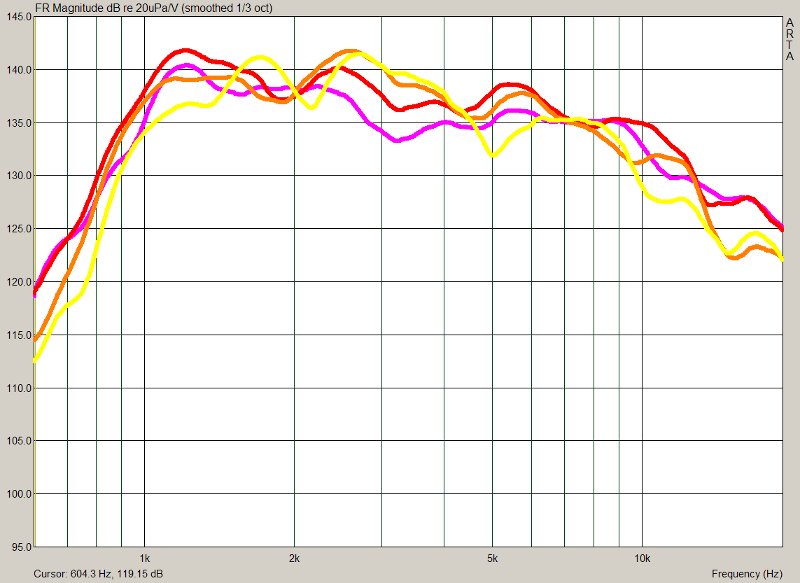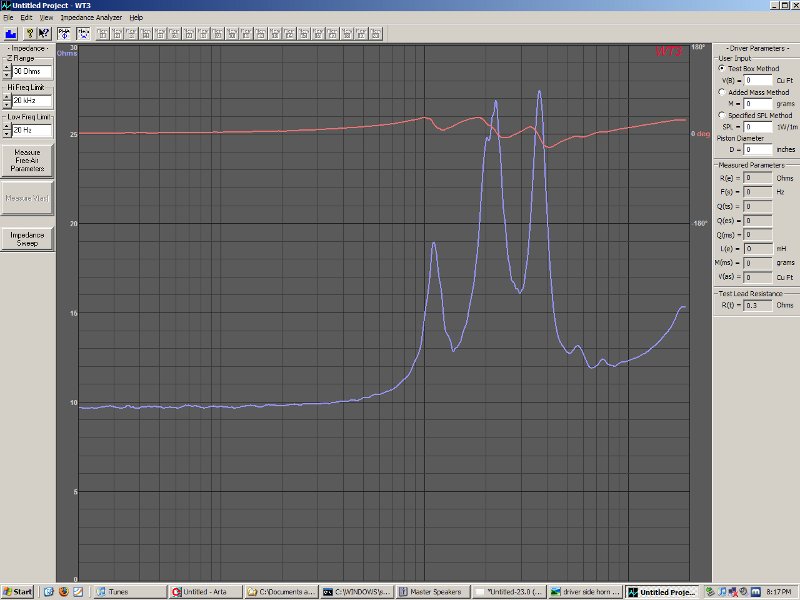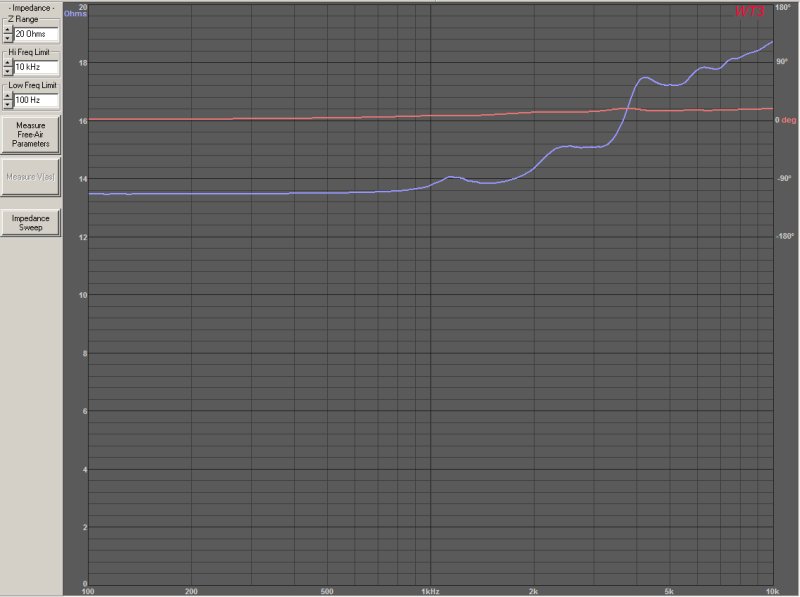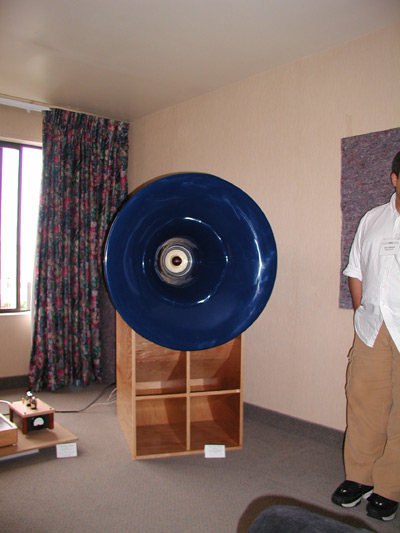That would be extremely beneficial
Over on diymobileaudio.com I did a measurement of a Polk two-way, mounted in the kick panels of my Accord.
The measurements confirmed what I already expected:
The on-axis response of a conventional two way is good, but as soon as you move off-axis the response goes to hell. It's particularly bad when interdriver-spacing is high. (In the Polk the center-to-center distance is about five inches; in your typical car stereo it's a foot or two.)
Even hardcore audiophiles rarely do polar measurements, so it's hard to appreciate how atrocious conventional speakers measure until you spend some quality time with a microphone and gated measurements.
Stereophile is a good start - John Atkinson's objective measurements have served as an admirable "second opinion", particularly when you realize that John's measurements frequently contradict the subjective review.
Anyways, hearing is believing, so if you're in my neck of the woods, come hear it tomorrow:
I'm going to bringing my Accord, with OS waveguides, horns and tapped horns, to the Audio Fest on Mercer Island tomorrow.
www.audiokarma.org/forums/showthread.php?p=3057229
If I can squeeze them into the car, I'll be bringing my Summas up too. Should be interesting. I've managed to cram them into my car before, but it's tricky...
Info on the car is here:
http://www.diyaudio.com/forums/showthread.php?threadid=148006
The correct link for Mercer Island DIY Meet:
http://www.audiokarma.org/forums/showthread.php?t=240059
http://www.audiokarma.org/forums/showthread.php?t=240059
I have a question about the measurement process- do you do any spatial averaging or are you just measuring at one point and then 1/3 octave smoothing that to get the displayed curves? If you're not doing spatial averaging, you might want to consider it- say 4-6 measurements within a head-sized area at each measurement point; take the (FR magnitude) average and then 1/3 or 1/6 octave smooth that to get a better idea of what you'd "hear" at that location.
Someone emailed me with some questions about the foam inside of the waveguides and the horns; thought I'd post the answer in the thread, in case anyone else is building horns for the car, or modding USD and Image Dynamics horns. Here's the reply to their email:
Ideally the foam would go all the way down to the diaphragm. I removed the bug screen on the waveguides that are on the dash of my car, and put the foam all the way down the throat. So the entire waveguide is filled.
The foam "soaks up" reflections inside the waveguide. Since reflections are delayed in time, that improves intelligibility of the waveguide, and reduces "higher order modes", which give conventional horns that nasally honk and harshness that's so obnoxious. Google "HOM" and "diyaudio" for more info. Subjectively it makes the sound seem to move back all the way to the throat. Without the foam, the sound from the waveguide seems to emanate from the mouth, not the throat. While that may seem like a subtle difference, it pushes the entire soundstage back a few inches. And in a car, that's a Very Good Thing.
It also smooths the response.
The downside is that you lose some efficiency, but these things are 110db efficient, so losing 2 or 3 db isn't a big deal.
As for the PVC, I put it all the way into the mouth, just out of sheer curiosity. Theoretically, reducing the mouth size will raise the F3 on the horn. But the measured results don't show a change in F3, so this is just one of those things where the sims don't agree with how the horn behaves "in the real world."
The horns in my own car only have the roundover underneath. You can see some pics and measurements of them here:
http://www.diyaudio.com/forums/showthread.php?p=1906837
Ideally the foam would go all the way down to the diaphragm. I removed the bug screen on the waveguides that are on the dash of my car, and put the foam all the way down the throat. So the entire waveguide is filled.
The foam "soaks up" reflections inside the waveguide. Since reflections are delayed in time, that improves intelligibility of the waveguide, and reduces "higher order modes", which give conventional horns that nasally honk and harshness that's so obnoxious. Google "HOM" and "diyaudio" for more info. Subjectively it makes the sound seem to move back all the way to the throat. Without the foam, the sound from the waveguide seems to emanate from the mouth, not the throat. While that may seem like a subtle difference, it pushes the entire soundstage back a few inches. And in a car, that's a Very Good Thing.
It also smooths the response.
The downside is that you lose some efficiency, but these things are 110db efficient, so losing 2 or 3 db isn't a big deal.
As for the PVC, I put it all the way into the mouth, just out of sheer curiosity. Theoretically, reducing the mouth size will raise the F3 on the horn. But the measured results don't show a change in F3, so this is just one of those things where the sims don't agree with how the horn behaves "in the real world."
The horns in my own car only have the roundover underneath. You can see some pics and measurements of them here:
http://www.diyaudio.com/forums/showthread.php?p=1906837
I have a question about the measurement process- do you do any spatial averaging or are you just measuring at one point and then 1/3 octave smoothing that to get the displayed curves? If you're not doing spatial averaging, you might want to consider it- say 4-6 measurements within a head-sized area at each measurement point; take the (FR magnitude) average and then 1/3 or 1/6 octave smooth that to get a better idea of what you'd "hear" at that location.
Yes, the polar response is spatially averaged. The curves that I've published are measured at 0, 15, 30 and 45 degrees. For each one of those points, I'm taking three measurements.
So I do a total of 12 measurements to produce 4 curves.
Time consuming to say the least
Also, the curves have slowly been getting smoother as this project has progressed. It's not that I'm using more smoothing on the graphs, it's that I discovered a way to use dual gates in Arta. So basically there's one gate for low frequency, another for high frequency, and then they're spliced.
Also, I generally use a gate time that's longer than necessary. This improves the low frequency accuracy at the expense of high frequency reflections.
This is one of the reasons the high frequency measurements are noisy.
Subjectively, I'm very VERY happy with the performance of this system above 1khz, so I'm using lengthy gates to get good date below 1khz.
In the next few weeks I'll be adding a pair of midbasses to fill in the response between the midranges and the subwoofers. More than likely the midbasses will be *behind* the listener, so we'll be having some fun with psychoacoustics to trick the listener into hearing the stage in front.
Think those 4540s could go down to 1200-1500 hertz with a 48 dB slope?
Yes and no...
My 4540s have a significant amount of output below 2khz in my car, but I'm crossing them over at 3 or 4khz. (Can't rememeber off the top of my head.)
At the moment I'm using an L-Pad to lower the efficiency of the compression driver, and then a *single* cap to high-pass them.
While 3 or 4khz seems like a high crossover point, it works well with a compression driver, because it counteracts their naturally rising response at low frequencies.
When all is said & done, you wind up with a frequency response that's relatively flat, then drops like a rock at 1khz.
Keep in mind, this isn't an "ideal" crossover; I'm using EQ to achieve the desired shape.

Here's the "unfiltered" response of the 4540ND on my waveguide. From 1250hz to 5000hz, the response falls at 3db/octave, than accelerates to 6db/octave from 5000hz to 20000hz. The capacitor in series counters the rise from 5000hz and down.

This is the impedance without an L-Pad. A real nightmare, very difficult to tame those impedance peaks one-by-one.

Here's the impedance with two resistors in an L-Pad. Now this is an easy one to filter. I added an inductor in series with the parallel resistor also. The inductor raises the impedance at high frequencies, which counters the affect of the capacitor. Basically a 50 cent inductor raises the top octave by 3-6db.
Last edited:
This is a bit off topic, but people have emailed me about unity horns, since I've spent a few years experimenting with them.
Here are the questions I am often asked, along with the answers.
Where can I get the midranges for the Lambda Unity horn?
A few months ago I purchased a box of drivers, which I believe are identical to what's used in the Lambda unity horn. The drivers are hand-built, and assembled on a "as needed" basis. So getting them isn't as simple as calling up Parts Express or something. If you need a set, drop me a line. I have a whole box of 'em. If Nick from Lambda or anyone from Sound Physics Labs object to this, I'll stop selling them. I don't think anyone cares, since the Lambda Unity has been out-of-production for close to a decade.
How big should the holes be in a Unity horn?
If I were you, I wouldn't use holes. The design of the ducts on the Synergy horn and the Yorkville Unity horn is superior. This makes a BIG and measurable difference on the performance. If you *must* use a hole, put it at a location that's 1/4 wavelength from the upper limit of the midrange. So if you want to run the midrange to 2000hz, put the center of the hole 1.6875 inches from the throat. (13500 inches per second / 2000hz / 4)
Which compression driver should I use?
I have heard a Lambda Unity with a TAD compression driver, and it sounded excellent. An expensive driver, but an attractive option. I believe the B&C DE250 was more commonly used. There are crossovers available on the internet for both. If I'm not mistaken, the crossover for the B&C is newer than the crossover for the TAD.
My personal choice would be a compression driver from BMS; they deliver higher extension than the B&C. The downside is that you'd have to tweak the B&C crosssover to get it to work with the BMS. Danley himself has switched to the BMS in most of the new synergy horns, though a few use Faital Pro.
What can I do to improve the Unity horn?
OK, OK, I made up the last one. Nobody ever asks me how to improve the Unity horn. But anyways, here are a few ideas:
Hope that helps...
Here are the questions I am often asked, along with the answers.
Where can I get the midranges for the Lambda Unity horn?
A few months ago I purchased a box of drivers, which I believe are identical to what's used in the Lambda unity horn. The drivers are hand-built, and assembled on a "as needed" basis. So getting them isn't as simple as calling up Parts Express or something. If you need a set, drop me a line. I have a whole box of 'em. If Nick from Lambda or anyone from Sound Physics Labs object to this, I'll stop selling them. I don't think anyone cares, since the Lambda Unity has been out-of-production for close to a decade.
How big should the holes be in a Unity horn?
If I were you, I wouldn't use holes. The design of the ducts on the Synergy horn and the Yorkville Unity horn is superior. This makes a BIG and measurable difference on the performance. If you *must* use a hole, put it at a location that's 1/4 wavelength from the upper limit of the midrange. So if you want to run the midrange to 2000hz, put the center of the hole 1.6875 inches from the throat. (13500 inches per second / 2000hz / 4)
Which compression driver should I use?
I have heard a Lambda Unity with a TAD compression driver, and it sounded excellent. An expensive driver, but an attractive option. I believe the B&C DE250 was more commonly used. There are crossovers available on the internet for both. If I'm not mistaken, the crossover for the B&C is newer than the crossover for the TAD.
My personal choice would be a compression driver from BMS; they deliver higher extension than the B&C. The downside is that you'd have to tweak the B&C crosssover to get it to work with the BMS. Danley himself has switched to the BMS in most of the new synergy horns, though a few use Faital Pro.
What can I do to improve the Unity horn?
OK, OK, I made up the last one. Nobody ever asks me how to improve the Unity horn. But anyways, here are a few ideas:
- Put a big fat roundover on the mouth of the horn. My reference speakers are a set of Gedlee Summas, and they image very well. I think that part of the magic is the roundover on the cabinet, and the waveguide. If I were going to change ONE thing about the Unity horn, it would be the mouth termination. An unterminated horn will never image as well as a properly terminated horn.

Here's a gedlee design. Note the beautiful and gradual termination from the waveguide to the cabinet. This obsessive attention to detail is why they sound so damn good, and image like nothing else.
An externally hosted image should be here but it was not working when we last tested it.
Here's a Lambda Unity horn. Note there's absolutely no termination of the horn. The design is from a decade ago, when we didn't know that termination is such a big deal.
An externally hosted image should be here but it was not working when we last tested it.
Here's a newer Unity horn, from Yorkville. Note the mouth termination has improved, the holes are different, and it uses a waveguide instead of a rectangular conical horn. All are worthwhile improvements, and the Yorkville Unity horn is a VERY affordable high efficiency design which is often overlooked.
- Consider using a different midrange. After using a "real" unity midrange, and a cheap tang band on a Unity horn, I personally prefer the Tang Band. It isn't easy to work with, since you have to seal the enclosure by hand. But once you do that, the W2-852SH is small enough to couple very VERY close to the throat of the waveguide and this allows you to cross the compression driver higher, run the midranges higher, and use smaller ducts. All three things improve the midrange of a Unity horn.
- Neodymium midranges often have higher BL than conventional midranges, which extends the high frequency response. Despite it's dimunitive size, the tiny little Tang Band midrange has an efficiency of almost 96db on a horn, thanks to it's neo motor. The neo midrange from Misco works well, and the neo mids from Ciare look promising.
- You don't have to use a square conical horn with a Unity. Consider using a waveguide. The main advantage of a square conical horn is that the Unity can be arrayed, and the wooden horn is durable and easy to build. In a prosound environment, these are good things, but at home, a real waveguide offers a few advantages too.
Hope that helps...
Last edited:
John
Are you repainting the Summas?
nah - that's an Abbey I think. I wanted to post a pic that shows the level of attention that's paid to mouth termination. With the foam plug in place, it's hard to tell.
The more I mess around with horns, the more I think that the mouth termination is an essential aspect.
Yet 90% of the designs out there screw up the mouth termination to one extent or another.
A few examples:

No termination of the horn whatsoever, and the transition from the diaphragm of the piston to the horn is too abrupt.
An externally hosted image should be here but it was not working when we last tested it.
The horn is properly integrated into a baffle, but the sharp edge on the cabinet will generate diffraction. The diffraction will degrade imaging and intelligibility.
An externally hosted image should be here but it was not working when we last tested it.
Getting better...
Correct, that is an Abbey, I should have realized that.
You keep going and you'll catch on to a lot of my tricks. I have to be honest that I don't tell ALL that I know, that would not be a good idea, but I do tell enough that people like you who experiment readily will come to see why I do some of the things that I do that I don't talk about. So sometimes I can look at a design, like the ones above, and, like you, tell right away that they won;t sound good. People think that I am jumping to conclusions, but I'm not. I'm just not disclosing "how" I know.
You keep going and you'll catch on to a lot of my tricks. I have to be honest that I don't tell ALL that I know, that would not be a good idea, but I do tell enough that people like you who experiment readily will come to see why I do some of the things that I do that I don't talk about. So sometimes I can look at a design, like the ones above, and, like you, tell right away that they won;t sound good. People think that I am jumping to conclusions, but I'm not. I'm just not disclosing "how" I know.
Correct, that is an Abbey, I should have realized that.
You keep going and you'll catch on to a lot of my tricks. I have to be honest that I don't tell ALL that I know, that would not be a good idea, but I do tell enough that people like you who experiment readily will come to see why I do some of the things that I do that I don't talk about. So sometimes I can look at a design, like the ones above, and, like you, tell right away that they won;t sound good. People think that I am jumping to conclusions, but I'm not. I'm just not disclosing "how" I know.
Yeah, I get a chuckle when I see guys obsession about tweeter choices, as if there's some kind of magic involved. 90% of the time it's not the tweeter that sounds terrible, it's diffraction off the cabinet that's the problem. It's not magical pixie dust, or an esoteric diaphragm or the shape of the diaphragm. It's diffraction that's the problem.
An externally hosted image should be here but it was not working when we last tested it.
An externally hosted image should be here but it was not working when we last tested it.
An externally hosted image should be here but it was not working when we last tested it.
The last speakers in particular, the KEF R107s, image like crazy.
Last edited:
Yeah, I get a chuckle when I see guys obsession about tweeter choices, as if there's some kind of magic involved. 90% of the time it's not the tweeter that sounds terrible, it's diffraction off the cabinet that's the problem. It's not magical pixie dust, or an esoteric diaphragm or the shape of the diaphragm. It's diffraction that's the problem.
Well its also thermal handling. Those small tweeters can't take much signal before they start to compress. But thats simply a VC size issue and your right none of that other esoteric stuff matters at all.
Yet 90% of the designs out there screw up the mouth termination to one extent or another.
A few examples:

No termination of the horn whatsoever, and the transition from the diaphragm of the piston to the horn is too abrupt.
Hi John,
Actually this is a Le Cleac'h horn without the full roll back, but from simulations this is still much better than all sorts of other horns with sharp edges, cabinets, etc.
Is this "diffraction problem" also true for slot tweeters?
IE: JBL-2405 / Beyma CP-21 / Selenium ST-324.
Or is this baffle integration issue only for diffractions
wider than some arbitrarily small fraction of a wave?
Diffraction in the near field of any source is "a problem", but there are extenuating circumstances. Our hearing tends to be more sensitive to this problem above about 1 kHz, peaking at 2-3 kHz and falling after that. Below 500 Hz its not much of a problem because our hearing is not that accute at those frequencies. So for the most part its tweeters that need care, not woofers. But it would be true for any tweeter regardless of design.
Hi John,
Actually this is a Le Cleac'h horn without the full roll back, but from simulations this is still much better than all sorts of other horns with sharp edges, cabinets, etc.
A full roll back still has more diffraction that a flare into a flat baffle. Now no baffle is flat forever, but the larger it is the better. And when it does start back the radius becomes important. A flat terminated roll back, as shown, is the worst of all these options.
A full roll back still has more diffraction that a flare into a flat baffle. Now no baffle is flat forever, but the larger it is the better.
Of course, but no one does this. For example, your speakers are probably the best example (the biggest baffle outside the horn), but even there the cabinet is basically the size of the horn with the radius plus the radius at the edge of the cabinet. So if you have a horn with a full roll back, it will be almost identical to this. I suppose you could argue that a round horn in a square cabinet with large radii would be better as it would distribute the diffraction somewhat due to varying distances from the edge of the horn to the (square) edge of the cabinet.
And when it does start back the radius becomes important. A flat terminated roll back, as shown, is the worst of all these options.
Of course again. What I was trying to point out is that John was misleading in lumping the truncated roll back in with cabinets with sharp edges with dome tweeters. It's vastly different. A lot of this is probably because such a horn is becoming very directive at high frequencies which I know you'd probably object to, but if your goal is not CD but rather controlled and narrow directivity, the truncated roll back is not that big of a problem. Said another way, it would be a larger problem on an OS waveguide because there would be more high frequency energy to diffraction from the edge.
Hi John,
Actually this is a Le Cleac'h horn without the full roll back, but from simulations this is still much better than all sorts of other horns with sharp edges, cabinets, etc.
I just realized I've actually heard that speaker. If I'm not mistaken, that picture is from the Bottlehead show, in Silverdale Washington, in September of 2001.
And you built the sub IIRC, with a Lambda woofer. You documented it on your website.
- Status
- This old topic is closed. If you want to reopen this topic, contact a moderator using the "Report Post" button.
- Home
- Loudspeakers
- Multi-Way
- Creating a Soundstage with Waveguides and Psychoacoustics